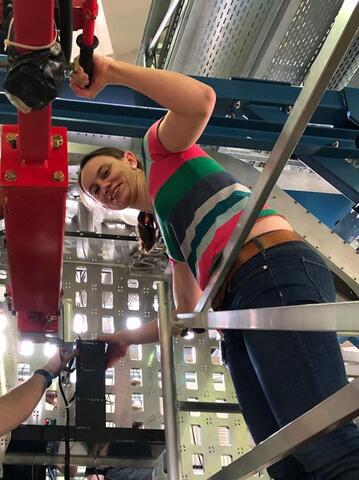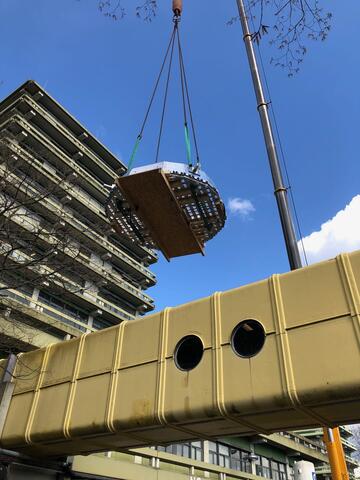Workshop „Physics Opportunities with Proton Beams at SIS100” was held in Wuppertal
Meike Küßner is DPG female physicist of calendar week 30 in 2023!
PANDA meetings
04/03-08/03 2024 CM 24/1 in Münster
24/06-28/06 2024 CM 24/2 at GSI
25/06-26/06 2024 FEE/DAQ Workshop
04/11-06/11 2024 CM 24/3 at GSI
05/03-07/03 2025 WS at GSI
16/06-20/06 2025 CM 25 in Uppsala
The Münster Cluster-Jet Target for the Future PANDA Experiment
S. Vestrick, P. Brand, D. Bonaventura, H. Eick, C. Mannweiler and A. Khoukaz
TA-CON-2022-035.pdf
(356.72 KB)
TA-CON-2022-035.pdf
(3.43 MB)
Alfons Khoukaz
The PANDA experiment will investigate proton-antiproton colli-sions with the utmost precision at the antiproton storage ring HESR at FAIR. It aims to address fundamental questions of QCD, i.e., mainly the theory of strong interaction and hadron physics [1,2]. The antiprotons with a beam momentum of up to 15 GeV/c will interact with protons delivered by a cluster-jet target. Due to the 4π detector surrounding the interaction point the cluster source and beam dump each need to be located in a distance of more than 2 m to the interac-tion point connected by a narrow jet beam pipe. For the success of this experiment it is indispensable to achieve world record target thicknesses in such large distances to the nozzle and develop a new state-of-the-art cluster-jet target.
A first prototype cluster-jet target was set up in Münster. Here, first investigations on beam properties were performed and the design tar-get thickness of 4.5×1015 atoms/cm² at the later interaction point in more than 2 m distance to the nozzle was reached [3]. Based on the obtained insights into cluster-jets and setup handling, the final Münster Cluster-Jet Target was designed which is topic of this presentation.
Within the cluster-jet target, hydrogen is cooled down to tempera-tures ranging from 20 to 40 K and pressed with 5 to 20 bar through a convergent-divergent Laval nozzle expanding into a first vacuum chamber (fig. 1). The resulting cluster-jet is separated from the gas background by a skimmer and afterwards tailored by a collimator, each optimizing the vacuum conditions. After a transition vacuum chamber, the cluster-jet is injected into the accelerator vacuum. With movable skimmer and collimator and a nozzle tilting system, the jet can be aligned within its beam pipe, crossing the interaction point after 2.25 m and entering the beam dump after in total nearly 5 m.
Three differentially pumped beam dump stages are separated by ad-justable orifices allowing to minimize the gas backflow (fig. 2).
Within the first stage an absolute thickness monitor system is in-stalled. Two orthogonal rods are moved one after another stepwise through the cluster-jet. Impinging clusters lead to a pressure increase proportional to the density of the cluster-jet. Furthermore, an MCP can be moved into the cluster-jet allowing for an online vertex zone visualization. In combination with an electron gun a total illumina-tion of the cluster-jet is possible which is a useful tool in aligning the cluster-jet through its narrow beam pipe and is a further way of determining the cluster-jet density. Additionally, by pulsing the electron gun the MCP system can be used for a precise velocity measurement of single clusters, which is needed for the thickness determination.
This state-of-the-art cluster-jet target setup and the implemented innovative beam diagnostic tools are topic of this presentation.
A first prototype cluster-jet target was set up in Münster. Here, first investigations on beam properties were performed and the design tar-get thickness of 4.5×1015 atoms/cm² at the later interaction point in more than 2 m distance to the nozzle was reached [3]. Based on the obtained insights into cluster-jets and setup handling, the final Münster Cluster-Jet Target was designed which is topic of this presentation.
Within the cluster-jet target, hydrogen is cooled down to tempera-tures ranging from 20 to 40 K and pressed with 5 to 20 bar through a convergent-divergent Laval nozzle expanding into a first vacuum chamber (fig. 1). The resulting cluster-jet is separated from the gas background by a skimmer and afterwards tailored by a collimator, each optimizing the vacuum conditions. After a transition vacuum chamber, the cluster-jet is injected into the accelerator vacuum. With movable skimmer and collimator and a nozzle tilting system, the jet can be aligned within its beam pipe, crossing the interaction point after 2.25 m and entering the beam dump after in total nearly 5 m.
Three differentially pumped beam dump stages are separated by ad-justable orifices allowing to minimize the gas backflow (fig. 2).
Within the first stage an absolute thickness monitor system is in-stalled. Two orthogonal rods are moved one after another stepwise through the cluster-jet. Impinging clusters lead to a pressure increase proportional to the density of the cluster-jet. Furthermore, an MCP can be moved into the cluster-jet allowing for an online vertex zone visualization. In combination with an electron gun a total illumina-tion of the cluster-jet is possible which is a useful tool in aligning the cluster-jet through its narrow beam pipe and is a further way of determining the cluster-jet density. Additionally, by pulsing the electron gun the MCP system can be used for a precise velocity measurement of single clusters, which is needed for the thickness determination.
This state-of-the-art cluster-jet target setup and the implemented innovative beam diagnostic tools are topic of this presentation.





